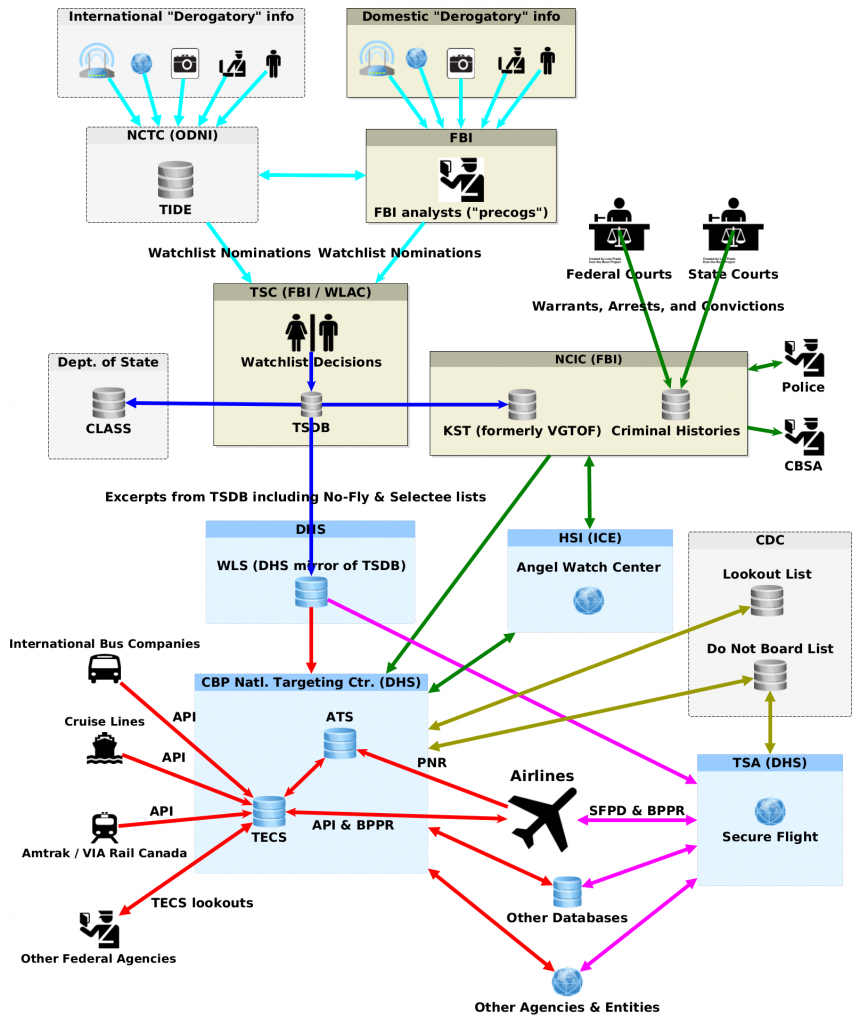“Put them on the no-fly list!”

[“How do you get on the no-fly list?” Larger image; PDF with legend.]
In the aftermath of the storming of the U.S. Capitol last week, there’s been a confused cacophony of calls to “put the rioters on the no-fly list.”
At the same time, there have been equally confusing claims and denials that some people found out that they had already been “put on the no-fly list” when they were denied boarding on flights home from Washington.
Are these people “on the no-fly list”? Could they be? Should they be? Is this legal?
More generally:
How do you get on the no-fly list? How do you know if you are on the list? How do you get off? What substantive and procedural legal standards apply?
The answers to all of these questions are much more complicated, and different, than many people seem to think — including the chairs of relevant Congressional committees, who ought to know better. The reality is that:
- There isn’t just one U.S. Federal government no-fly list — there are several, created by different agencies for different purposes.
- There are also non-list-based ways that real-time no-fly decisions can be made.
- No-fly decisions can be, and are, made independently, on the basis of different lists and other criteria, by multiple Federal agencies and by individual airlines.
So a better starting point for understanding what’s happening — before we can begin to assess whether it is legal or what should be happening — is to ask, “How can a would-be passenger be prevented from boarding a scheduled airline flight?”
The diagram above (larger version; PDF with legend of acronyms and color-coding) gives only a summary of the U.S. government’s no-fly decision-making process, not including individual airines’ no-fly decision-making practices. (We’ve published versions of the diagram before. The latest version above has been updated to include the Angel Watch Center, the CDC Do Not Board List and Lookout List, and the Watchlisting Advisory Council.)
As discussed in more detail below, no-fly decisions can be based on any of the following:
- U.S. government no-fly orders:
- Suspected terrorists and others associated with them (Terrorist Screening Database).
- People not suspected of terrorism, but flagged by real-time profiling algorithms implemented in the TECS/ATS or Secure Flight systems.
- Suspected infectious disease carriers (CDC Do Not Board and Lookout Lists).
- Arrest warrants (from NCIC, effectuated for international flights through TECS).
- People previously convicted, at any time in their life, of certain sex-related offenses (Angel Watch Center, for international flights).
- Airline no-fly decisions, based on:
- Airline conditions of carriage.
- Airline no-fly lists (created and maintained separately by each airline).
- Other non-list-based “rules” interpreted and enforced by airlines (most significantly the entry requirements described in the Timatic “travel information manual”).
How does all this work? Here are some FAQs about the no-fly list and no-fly orders: